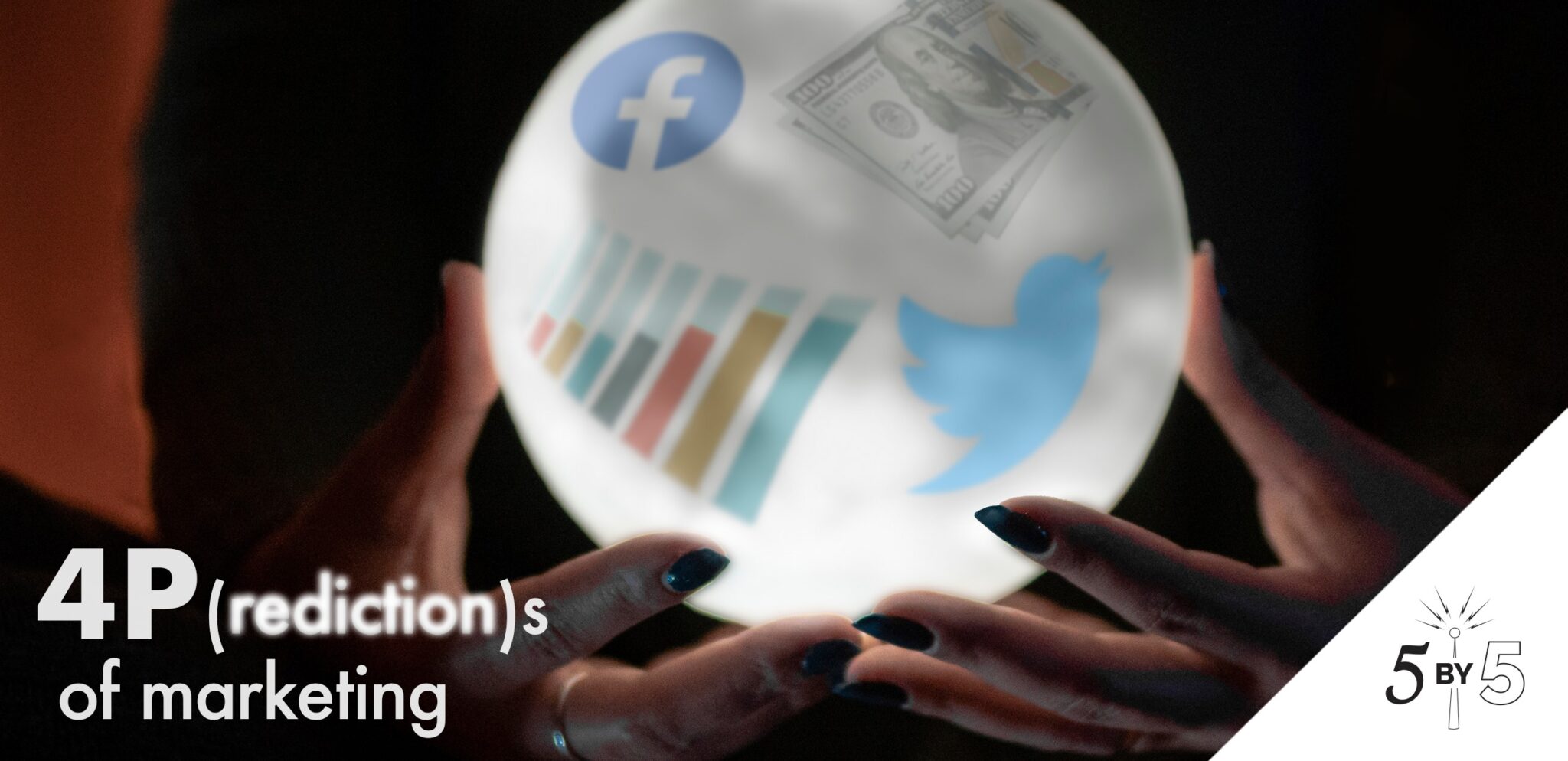
For marketers, 2020 was the year of the pivot. From strategies to objectives and brand messaging to social media ads, brands all over the world were hitting the pause button and rethinking the what, when, where, why and how of every campaign. E-commerce sites exploded, hundreds of live events (including the Summer Olympics) were cancelled, and millions of Zoom accounts were created. Now that we’ve had a minute to get used to—if not comfortable with—this new normal, it’s time to start thinking about what 2021 might look like and how you can position your brand so that it’s prepared for whatever the new year brings.
The million-dollar question is this: What do you need to do in order to successfully build your brand, engender loyalty and drive sales in 2021?
If you took any marketing courses in college, you might be familiar with the four P’s of marketing (product, price, place, promotion). Now, there are four more ‘P’s’ for you to consider. Here’s what we think marketing will look like in 2021 and what that means your brand will need to do for a successful year ahead.
In 2021, Marketing Must Be More Personal
We’ve been nearly 100% digital for the better part of 2020. We’re growing tired of virtual meet ups and Zoom conferences and many of us long to connect in real life. But just because consumers are craving face-to-face engagement doesn’t mean your online presence isn’t important. In fact, it’s arguably more important than ever because it’s the path to reaching your audience where they are. 2021 will likely be a transition year, and that requires a thoughtful strategy that includes short- and long-term plans.
Until you can safely hold in-person events and welcome customers into your stores without restrictions, focus on laying the groundwork to blur the lines between online and off. This type of omni-channel approach will make the transition that much more seamless for your customers when the time comes. Keep in mind, too, that even when the pandemic is behind us and the economy has recovered, our world will be forever changed. The windshield is much bigger than the rearview mirror, and brands preparing now will be in a stronger position to lead the way. A few thought starters to consider as you lay that groundwork:
- Where in the path to purchase do customers begin interacting with your brand? Would it make sense to add offline or digital touchpoints at additional stages (awareness, consideration, purchase, loyalty)?
- Does your audience prefer to search via mobile or desktop? Where are they (in route, at home, at the office) when performing searches? Has the shift to remote work changed when and where they search? And could it change yet again? An omni-channel approach can help you prepare for all scenarios.
- What role does your brand play for your audience? Do you help them relax and unwind? Think bigger? Be more productive? How can your brand’s role evolve in 2021 to better meet your audiences’ needs or meet more of their needs?
Key Take-away:
Personal marketing will evolve to mean more than just customized emails or highly-targeted ads. In 2021, consumers will look to distance themselves from divisiveness online, instead connecting with others around a brand, geographic area or demographic community. Social media groups will continue to gain popularity for their ability to bring like-minded people together. Get in front of your audience—and the competition—by inviting consumers to engage on a deeper level with your brand. Consider creating a Facebook Group, and keep an eye on the new ‘Neighborhoods’ offering. Be ready for your audience with content that addresses every stage along their path to purchase.
Related: Discover 7 ways to build an engaged social media community
In 2021, Marketing Must Be More Proactive
The nature of social media is largely reactive. Brands wait to hear from customers in the form of reviews, comments, likes, and mentions – and then we respond in kind. But what if you could preempt those reviews and complaints? What if you knew what they were thinking, what they were talking about in their social circles and you could publish content that speaks directly to their fears, desires, needs, or questions? This is where social listening comes in. Rather than guess at what your audience wants from you, social listening allows you to tap into real-time conversations happening around your industry and your brand. When you know what people are talking about and what questions or concerns they have, you can address these in the form of branded content that adds value.
Rather than waiting for your audience to grow organically, be proactive about going out and finding key target audiences who may not know about your brand. Proactively reach out to potential customers in new markets with paid social media ads that grab their attention and entice them to click. Discover your most loyal customers and fans and give them an opportunity to show their loyalty through brand advocate and micro-influencer campaigns.
Key Take-away:
Be ready when and where your audience is, but don’t be a wallflower when it comes to joining the party. Use comment marketing to be seen and heard in new circles and drive attention back to your brand’s owned and shared spaces. Pay attention to conversations happening in your industry and listen for opportunities to give your most ardent supporters a voice.
In 2021, Marketing Must Be More Predictable
2020 brought a new headline nearly every day of the week. After nearly a year of unpredictability, health scares and job layoffs, we’re betting consumers will likely crave a little predictability in 2021. Your consumers want to know that your brand will act, look, talk, respond, and provide in a predictable, steady way. That doesn’t mean your brand has to be boring. You also need to look for ways to stay relevant and fresh. That’s the great balancing act of content marketing. The benefits are well worth the discipline and effort this requires: not only do audiences look for high-quality content, but Google, does too. Strong SEO requires consistent content output, according to Kissmetrics.
Build a library of evergreen content that drives brand awareness and business growth. Finally, focus on your CTAs, not just what they are, but where they are within your content. By clicking on a call to action, that visitor is choosing to engage with your brand, which makes them much more valuable (not to mention predictable) than a cold list of leads that may or may not have interest in your products or services.
Create unique content that matches both your audience’s interests and your brand’s knowledge. When you create that clear path through the sales funnel with your content, you’re designing a predictable path to purchase at scale.
That doesn’t mean you shouldn’t be proactive – as we suggest above. It means you should be proactive in a way that is reliable, trustworthy, and expected. It also doesn’t mean you can’t throw them a curve ball once in a while to keep interest high and keep folks engaged. A social media contest or giveaway can be a welcome distraction from the norm.
Key Takeaway:
Publish a regular cadence of unique content and engage regularly with social media audiences. You know your industry and your brand better than anyone else, so focus on being authentic and sharing your knowledge in the best way you know how and take advantage of content creation experts who can continue to add content for every stage of the buyer journey to your brand’s asset library.
In 2021, Marketing Must Be More Profitable
Of course, you want to see a high return on your marketing investments. But now is the time to be intentional with your efforts. We’ve been touting the availability of data for several years now, but more than 95% of business leaders still make decisions using intuition. Chances are you know your audience pretty well, but leading with data allows you to either confirm or correct those instincts.
It can be overwhelming to dive into all the data at once and pretend to know what it means, much less make informed decisions based on it. Focus on one piece of content at a time and start by matching your objectives to specific Key Performance Indicators (KPIs). Let’s say you’re running a LinkedIn ad to sign customers up for IT services. If your ad earns a high number of click-thrus but your annual contracts haven’t increased, pause the ad while you assess the problem. A high percentage of click-thrus means your ad copy and CTA are working well, but something on the landing page is causing them to drop off. Are visitors leaving before signing up? You might try changing the call to action or rearranging the page so that your lead form isn’t missed by visitors who don’t scroll.
While it can be difficult to determine the ROI of your social media efforts, over time you should see growth in terms of audience, reviews, appointments, and revenue. Publishing one blog a week might not show up in terms of increased profit within the first year, but what should be clear is that your audience is clicking through more pages of your site and spending more time on a page. That means you’re creating stronger relationships which will lead to higher profits. Patience is key when it comes to seeing paid media results. Our friends at B Squared do a great job of explaining why here.
Key Takeaway:
Slow down, test, and take it one objective at a time. Focus on seeing an ROI with a key piece of content or one stage of the sales funnel before moving on to others. Run one ad at a time and let the results of that one ad determine what the next one looks like. That gives you time to let results come in and see how well a strategy is working. Look at where you can save by using internal resources and then supplement with strategic consulting to “optimate” your results.
Related: Learn which data to measure at every stage of the buyer journey
We’re all looking ahead to 2021. Make it a banner year with smarter, more cost-effective marketing strategies that lead to stronger bottom line results.


